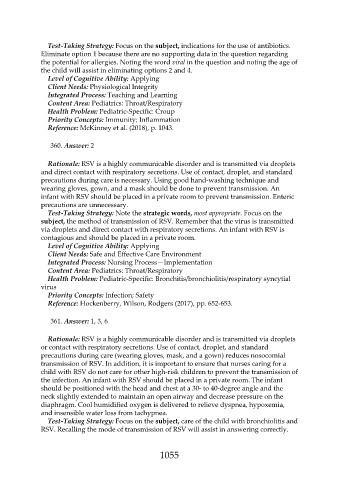Page 1055 - Saunders Comprehensive Review For NCLEX-RN
P. 1055
Test-Taking Strategy: Focus on the subject, indications for the use of antibiotics.
Eliminate option 1 because there are no supporting data in the question regarding
the potential for allergies. Noting the word viral in the question and noting the age of
the child will assist in eliminating options 2 and 4.
Level of Cognitive Ability: Applying
Client Needs: Physiological Integrity
Integrated Process: Teaching and Learning
Content Area: Pediatrics: Throat/Respiratory
Health Problem: Pediatric-Specific: Croup
Priority Concepts: Immunity; Inflammation
Reference: McKinney et al. (2018), p. 1043.
360. Answer: 2
Rationale: RSV is a highly communicable disorder and is transmitted via droplets
and direct contact with respiratory secretions. Use of contact, droplet, and standard
precautions during care is necessary. Using good hand-washing technique and
wearing gloves, gown, and a mask should be done to prevent transmission. An
infant with RSV should be placed in a private room to prevent transmission. Enteric
precautions are unnecessary.
Test-Taking Strategy: Note the strategic words, most appropriate. Focus on the
subject, the method of transmission of RSV. Remember that the virus is transmitted
via droplets and direct contact with respiratory secretions. An infant with RSV is
contagious and should be placed in a private room.
Level of Cognitive Ability: Applying
Client Needs: Safe and Effective Care Environment
Integrated Process: Nursing Process—Implementation
Content Area: Pediatrics: Throat/Respiratory
Health Problem: Pediatric-Specific: Bronchitis/bronchiolitis/respiratory syncytial
virus
Priority Concepts: Infection; Safety
Reference: Hockenberry, Wilson, Rodgers (2017), pp. 652-653.
361. Answer: 1, 3, 6
Rationale: RSV is a highly communicable disorder and is transmitted via droplets
or contact with respiratory secretions. Use of contact, droplet, and standard
precautions during care (wearing gloves, mask, and a gown) reduces nosocomial
transmission of RSV. In addition, it is important to ensure that nurses caring for a
child with RSV do not care for other high-risk children to prevent the transmission of
the infection. An infant with RSV should be placed in a private room. The infant
should be positioned with the head and chest at a 30- to 40-degree angle and the
neck slightly extended to maintain an open airway and decrease pressure on the
diaphragm. Cool humidified oxygen is delivered to relieve dyspnea, hypoxemia,
and insensible water loss from tachypnea.
Test-Taking Strategy: Focus on the subject, care of the child with bronchiolitis and
RSV. Recalling the mode of transmission of RSV will assist in answering correctly.
1055

